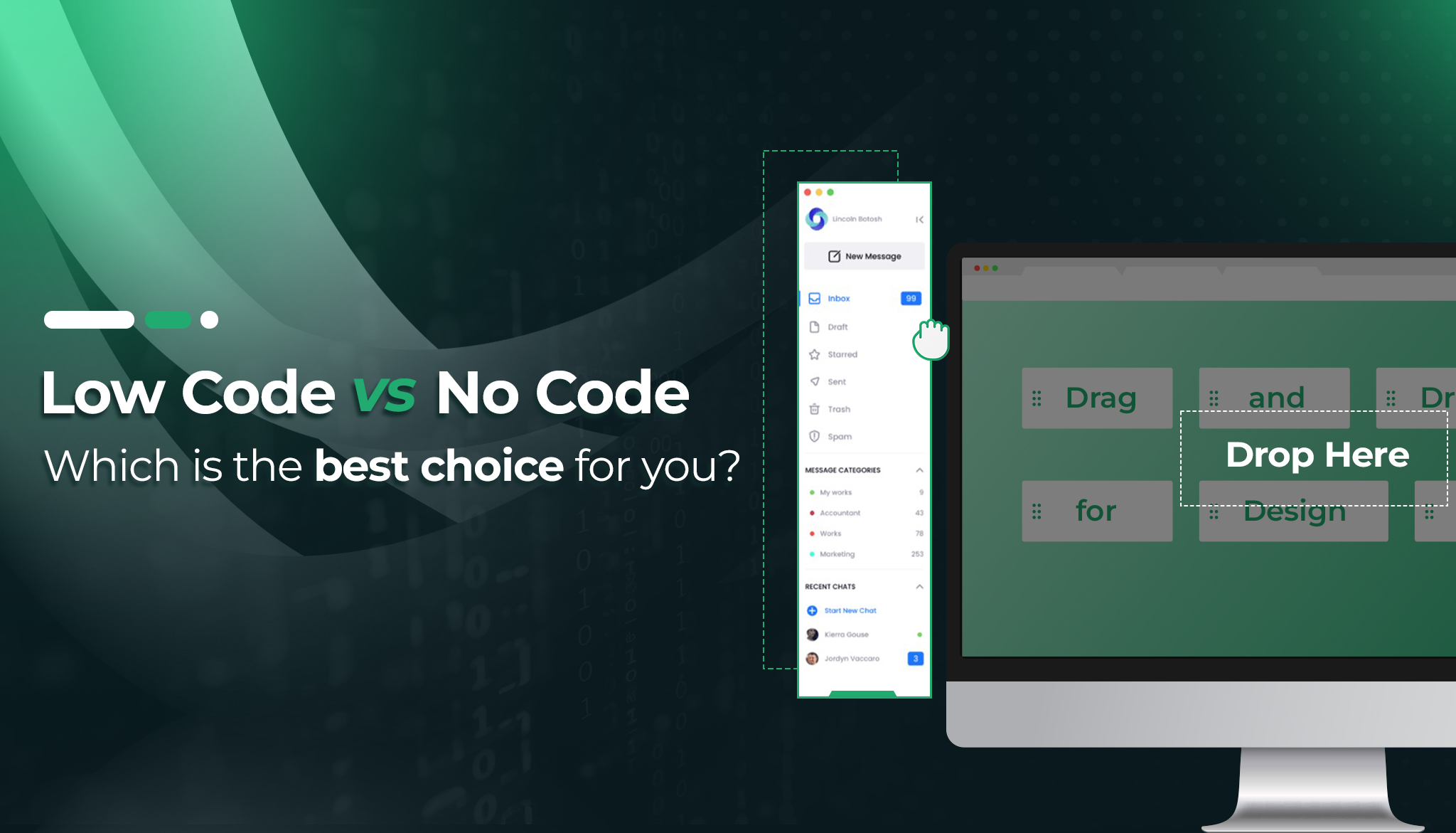Businesses today are constantly looking for ways to smooth out their development processes and increase efficiency. One of the latest trends in the tech industry is the rise of low-code platforms. These platforms allow users to build applications with minimal coding knowledge, allowing individuals with limited technical expertise to develop custom software solutions. Additionally, they offer greater ease and accessibility for expert developers, letting them deliver customized applications efficiently, effectively, and with greater customizability.
What is a Low-Code Platform:
Low code is a graphical software development technique that allows developers to design apps while avoiding traditional, complex hand-coding processes. Low code development platform provides a user-friendly, drag-and-drop development environment, making app creation accessible to both coding novices and seasoned professionals.
Another term one might encounter when working with low code is no code. No-code platforms also use a similar visual/graphical, drag-and-drop, development method but require no prior knowledge or programming skills to build apps.
Low code vs. No code:
Low-code platforms require users to have some knowledge of programming while no-code platforms require no prior know-how of coding, respectively. Both these platforms at the core are created to make the complex app development cycle easy and quick for both experienced developers and non-tech savvy users.
What to choose?
Both Low-code and No-code development platforms are aimed at making the process of developing an application easy but both these development strategies cater to different crowds and scenarios.
Low Code Development
Low-code platforms speed up the app creation process with the added benefit of flexibility and customization with programming. Experienced developers could embed and integrate their own code if some fine-tuning is required. Furthermore, low-code platforms allow additional functionality and features to be added to the app using traditional coding.
What is its Use Case: Low-code platforms are a perfect fit for companies that need quick enterprise or business application delivery but want customization flexibility.
Top Low Code platforms:
- Appian: Appian is a low-code platform that allows for rapid application development with minimal coding. It is known for its ability to integrate with various systems and data sources, making it a popular choice for enterprises
- Mendix: A low-code platform that offers a visual development environment for building both web and mobile applications. Mendix is known for its robust features and strong community support
- Microsoft PowerApps: PowerApps is a low code development platform introduced by Microsoft, it enables users to create custom business applications with a drag-and-drop interface. It is known for its seamless integration with other Microsoft products and services
- OutSystems: OutSystems is a Low-code development platform that provides tools for companies to develop, deploy, and manage omnichannel enterprise applications. It is known for its robust features and strong community support
- Salesforce Lightning: Salesforce Lightning is a component-based framework for building modern and responsive web applications on the Salesforce platform. It allows developers and administrators to easily create custom user interfaces and business logic using pre-built components and drag-and-drop functionality.
No Code Development
No code development environment is tailored more towards someone who has zero knowledge about coding and is an absolute beginner. In a no-code environment, every development step is graphically represented and usually, the entire process is drag and drop, from designing user interfaces to automating processes.
What is its Use Case: No-code is a match made in heaven for business users or citizen developers looking for quick and uncomplicated app crafting.
Top No Code platforms:
- Airtable: Airtable allows users to create custom applications with a spreadsheet-like interface. It is known for its ease of use and flexibility.
- AppGyver: Now owned by SAP, AppGyver is a no-code platform that offers a visual development environment for building web and mobile applications. It is known for its robust features and strong community support.
- Google AppSheet: AppSheet is a no-code platform by Google, it allows users to create custom business applications with a spreadsheet-like interface. It is known for its integration with Google Workspace and its focus on automating business processes.
- Appy Pie: Appy Pie is an AI-powered no-code platform that offers a visual development environment for building web and mobile applications. It is known for its ease of use and flexibility.
- Bubble: Bubble is a full-stack, no-code platform that offers a visual development environment for building web applications. It is known for its robust features and strong community support.
Pros and Cons of Low Code:
Low-code platforms are quite popular nowadays because of their ability to accelerate the development process and reduce the reliance on traditional software development methods. This has led to increased productivity and cost savings for businesses of all sizes. However, some experts argue that low-code platforms may pose risks to organizations in terms of security, scalability, and customization capabilities.
Pros of Low Code Platforms
Low-code platforms offer a range of benefits for businesses looking to quickly create and deploy applications. They allow users to drag and drop pre-built components, reducing the need for extensive coding knowledge. This can significantly speed up the development process and enable non-technical team members to contribute to app development.
Additionally, low-code platforms often come with built-in integrations and plugins, making it easier to connect various systems and databases. This can help businesses streamline their operations and improve data accessibility. With low-code platforms, organizations can quickly prototype, iterate, and test new ideas, allowing for rapid innovation and agility in the market.
Cons of Low Code Platforms
Despite the advantages, low-code platforms also have drawbacks that businesses and individuals should consider before adopting them. One of the main concerns is the risk of security. Since low code platforms automate much of the development process, there is a higher chance of overlooking important security measures, leaving your applications vulnerable to cyber attacks.
Another issue is the potential lack of customization options with low-code platforms. While it is true that these platforms offer unique pre-built components and templates, these templates may not always fit with the specific requirements of a business. This can limit the flexibility and scalability of applications developed using low-code platforms, making it challenging to meet specific business needs.
Pros and Cons of No-Code Platforms:
Pros of No Code Platforms:
No code platforms similar to low code are efficient and simple to get into, they share the same drag-and-drop mechanics as the low code platforms, the one thing that is not common between the two is with low code development environments one needs to have some basic know-how of coding to fully create and customize an app but with No Code platforms, as the name suggests, no coding experience is required. This no-code approach not only makes it significantly easy for anyone to get into and a lot cheaper as you don’t have to hire a team of experienced developers or involve any app development company in the mix, thereby saving both time and resources.
Cons of No Code Platforms:
Despite their advantages, no-code platforms also have their drawbacks. One notable limitation that immediately stands out is their scalability. While no-code platforms are great at building simple applications, these platforms may struggle with more complex and large business logic and workflows, bottlenecking (restricting) the scope of applications that can be effectively developed. Additionally, organizations that are very heavily reliant on no-code platforms usually become overly dependent on the platform provider for ongoing support and maintenance, potentially creating risks in the long term.


